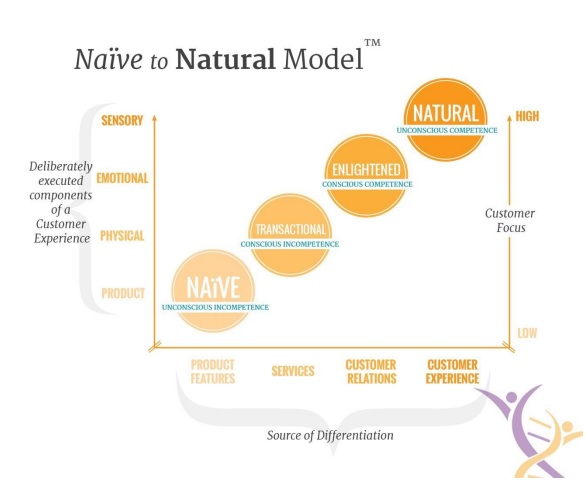Twenty years working in Customer Experience taught me that it’s about a mindset. The mindset leaks out into the organization, recruitment processes, measurement programs and eventually becomes your organization’s culture. The mindset becomes “the way we do things around here.” In a recent podcast, we looked at how we assess organizations’ mindsets, particularly about customers.
When we assess an organization’s customer-centricity, we uncover signs that help us ascertain how customer-centric they are. Customer centricity describes how the organization views their customer. Customer-centric companies do what is good for the customer; other companies do good for the organization or stakeholders. A customer-centric organization builds its experience around the customers; the others do not.
In 2004, I wrote a book called Revolutionize Your Customer Experience. Through research for the book, we found there were four types of organizations regarding their orientation toward customers: Naïve, Transactional, Enlightened and Natural Organizations:

Four Customer Orientations of Organizations
- Naïve: Companies either by choice or ignorance choose not to put customers at the center of what they do.
- Transactional: Firms that focus on themselves and treat customers as something to be processed.
- Enlightened: Organizations that recognize there is emotion in experience but lack a holistic view of the customer.
- Natural: These are the cream of the crop companies that naturally put customers at the center of everything they do.
Every company is somewhere on a continuum in these four customer orientations. We find that majority of companies are Transactional, meaning they process customers. However, there are few Natural companies that get it when it comes to Customer Experiences, like Disney, Apple, and the Ritz Carlton.
We also learned there are nine different areas of influence on those four customer orientations. These influences are People, Culture, Marketing, Measurement, Systems, Strategy, Customer Expectations, Channel Approach, and Process.
Let’s take a closer look at the first two areas, People and Culture.
Area #1: People
A significant area with a critical impact on an organization’s customer orientation is People.
When I assess an organization’s customer orientation in the People area, I consider a few things. First, I analyze what recruitment emphasizes in the selection of the team. Do they look for specific skills and product knowledge or attitude? Or both? More? Based on the answer, we then know where they are as far as customer orientation in People. For example, a naïve company would only look at specific skills and product knowledge, while a transaction company would add in a vague description like “good attitude.” Enlightened organizations would look for people with good emotional management skills, and Natural companies would use a psychometric measurement in the emotional capabilities to see how intrinsic those skills are.
Under the heading of people, there are 12 different things that we would look at, not just recruitment. For example, another area would be soft-skills training. If an organization doesn’t do any soft-skills training for managing customer emotions, they are Naïve. If they do only a little every once in a while, then Transactional, and so on.

An anecdote might help illustrate what I mean. I was once talking to a Transactional organization about their 8-week training for call center employees. I asked how much of that they spent on dealing with customers, and they said half a day. For me, that sums it up. The mentality that out of eight weeks of training, they devote only half of one day to customers says a lot about their customer orientation. On the other hand, an Enlightened or Natural organization could identify the emotions they are trying to evoke and explain the team’s training to produce those emotions. The main difference between the Enlightened and Natural companies here is that Natural companies would also go into behavioral science and the fundamental principles of psychology.
Another example of assessing a company’s customer orientation in People is how they view their employees. If they think their employees are a commodity and don’t trust them to solve problems because they believe it is too complex to handle, they are on the Naïve to Transactional side. However, if they empower their employees to solve customer problems at whatever cost and without asking permission, they are Natural.
Employees are human beings, which means that behavioral sciences apply to their experiences, too. So, for example, in a recruitment process assessment, we might also ask an organization where the Peak emotion is of the process and how it ends to determine the Peak-End Rule of that area. We might also ask what feeling they want to evoke from employees. We want to see if it is the same as the organization seeks to elicit from customers.
We take on this level of assessment because we want to ensure that putting the customer at the center of everything an organization does is baked into the culture to a depth that those values are reflected in how you treat your people. I based this strategy on the book I read years ago, The Service Profit Chain by James Heskett, Earl Sasser, and Leonard Schlesinger. To oversimplify their work, the idea of the book is that if you focus on your people, the Customer Experience will follow. (That concept is the same one that guides my eBook, Happy Employees Make Happy Customers.) Richard Branson is also famous for saying, “Clients do not come first. Employees come first. If you take care of your employees, they will take care of the clients.” Both of these reinforce the same idea that organizations need to treat employees well so they will treat your customers well. In Natural Customer-Oriented organizations, we see a consistency of treating people like humans and valuing them highly, whether they are customers or employees.
Area #2: Culture and Leadership
When we assess an organization for Culture and Leadership, we want to know if the idea of putting the customer at the center of everything comes down from the top. We assess this area for customer orientation is to ask how much time the senior managers spend with customers. If the answer is never, then we know that the organization is Naïve. If it’s a couple of times of year senior managers interact with customers, then Transactional. Enlightened organizations have a more regular interaction between customers and senior management, and Natural organizations interact all the time. In other words, the more contact senior managers have with customers directly, the more it shows that an organization values customers.
For me, senior managers must do this because it is easy to lose touch with the reality of the business without regular interaction with customers. Without that time on the front lines, senior managers don’t understand the problems, leading to decisions that are not good for customers. Unfortunately, we know from the concept of Confirmation Bias that senior managers will think they know what’s going on with customers, but they won’t. In the past, we have tried exercises to get senior management back in touch with customers. One of them was getting the same number of customers in a room as senior managers and then having them talk for a few minutes, like speed dating but for customer interactions. Another way to keep senior managers in touch is to task them with customer complaint management every month to see the problems for themselves rather than isolating them in their ivory towers.
Another way I like to assess the Culture and Leadership area for an organization is to look at the position of Customer Experience issues on a team meeting agenda. Naïve organizations wouldn’t have it on the schedule at all. Transactional organizations would have it, but at the end; then they can cut it if they run out of time. Enlightened organizations would move it up to the middle of something. In contrast, Natural organizations would lead the meeting by talking about the latest customer feedback voice or Net Promoter Scores® or how customers feel.
 Another example of assessing Culture and Leadership is the degree to which they define culture. It surprises me how often organizations do not express their culture. So Naïve organizations wouldn’t have it represented, and it wouldn’t be on their radar that it should be. Transactional companies would also not have it defined but would at least know they probably should. Enlightened organizations would be working on defining it already. Natural organizations would have it defined and so engrained in the team that it would be cultish. It isn’t something that employees have to pretend to be a part of or change their mindset in the parking lot before they get out of their cars, either. Employees fit into the culture and are part of the family.
Another example of assessing Culture and Leadership is the degree to which they define culture. It surprises me how often organizations do not express their culture. So Naïve organizations wouldn’t have it represented, and it wouldn’t be on their radar that it should be. Transactional companies would also not have it defined but would at least know they probably should. Enlightened organizations would be working on defining it already. Natural organizations would have it defined and so engrained in the team that it would be cultish. It isn’t something that employees have to pretend to be a part of or change their mindset in the parking lot before they get out of their cars, either. Employees fit into the culture and are part of the family.
So, to summarize, there are four customer orientations that most organizations have, which include Naïve, Transactional, Enlightened, and Natural. Then, nine areas make up those orientations. Today, we touched on a couple with People and Culture, which are two significant areas for any organization. I hope that this exercise inspires you to consider your organization and where it fits into these orientations and areas. The best thing you can do for your organization’s Customer Experience is to get into a mindset to move your company to a Natural place that puts the customer at the center of everything you do.
There you have it. No promotions, no gimmicks, just good information.
Think reading is for chumps? Try my podcast, The Intuitive Customer instead. We explore the many reasons why customers do what they do—and what you should do about it. Subscribe today right here.


